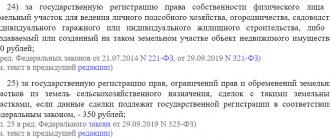3
The need to divide a land plot, both in shares and in kind, arises in many different cases.
It can be:
- division of land during divorce;
- division of land as part of heir disputes;
- allocation of a share in favor of one of the co-owners and other options.
Expert opinion
Stanislav Evseev
Lawyer. Experience 12 years. Specialization: civil, family, inheritance law.
But not in all cases it is possible to easily and simply divide a land plot, even if all owners and interested parties (owners of adjacent plots, for example) agree to the division. The legislation has such a concept as an indivisible plot, which is spelled out in more detail in Art. 11.9 of the Land Code of the Russian Federation.
In a broad sense, a divisible land plot is an actual allotment, on individual parts of which property rights can be established, despite the fact that such parts are independent, do not violate the regime of use and have separate boundaries.
What is an indivisible plot of land?
Determining whether the specified real estate belongs to the indivisible category is not an easy task, since this process depends on many indicators.
The main feature of this site is the impossibility of dividing it due to the fact that such actions may disrupt its use or change its intended purpose.
Example: A physical division of a land plot on which a multi-storey building is located, inhabited by residents, is not possible. Carrying out such a procedure is possible only if shares are allocated to each home owner, commensurate with the area of the apartments of such citizens. Thus, the land plot located under the specified residential property is indivisible. This is due to the fact that the allocation in kind of a part of the allotment to a tenant living in an apartment on the seventh floor of an apartment building is impossible, both physically and legally. The same situation applies to industrial and administrative buildings.
In addition, the possibility of determining whether real estate is indivisible also depends on the presence or absence of encumbrances on it, which may concern both the territory of the land plot as a whole and its individual component parts.
For example:
- restrictions on the right to use land, such as easements, a ban on placing real estate in areas protected by the state;
- restrictive measures regarding the disposal of the plot, for example, a mortgage loan, rent exceeding an annual period, arrest, concession;
- encumbrances relating not to the land plot, but to objects located on it, such as cultural monuments.
Important! The presence of these circumstances may create conditions for recognizing land as indivisible if encumbrances create a ban on its division. In other cases, the plot will be recognized as divisible. In addition, the timing and boundaries of these restrictions are of no small importance, the establishment of which will help determine the possibility of dividing the land.
Summarizing the above, we can come to the conclusion that an indivisible land plot is an allotment of land, for part of which the establishment of a separate property right is prohibited by law.
Thus, an area that is characterized by the following features:
- can only belong to one owner;
- acts as an object of common property if its owners are several persons;
- if a real estate property owned by two or more citizens is located on a plot, such a plot can only be in common shared ownership;
- due to its size, there cannot be a division, since the allocated parts of the site will not be fully suitable for exploitation and intended use.
About a composite thing
1. Article 133 of the Civil Code, judging by its title, speaks of indivisible things: “A thing, the division of which in kind is impossible without destruction, damage to the thing or a change in its purpose and which acts in circulation as a single object of real rights, is an indivisible thing in that case if it has component parts” (clause 1).
However, in fact, Art. 133 of the Civil Code mixes two different categories: indivisible things (which cannot be separated without losing their functionality) and composite things (i.e. formed by the mechanical connection of several simple things).
For example, a car is a classic example of a composite thing that is also indivisible. Meanwhile, composite things can also be divisible - for example, an ordinary cable, being a composite thing, is at the same time a divisible thing - if 30 m is cut off from a coil of such cable located in a store, none of the divided parts loses its purpose.
2. Clause 1 of Art. 133 of the Civil Code establishes a rule according to which all parts included in a composite thing lose their objectivity and turn into “components” of a new thing. For example, an engine installed in a car, plane or ship ceases to exist as an independent object of civil rights (legally dies), dissolving into this composite object.
At the same time, however, the law provides for the possibility of “legal revival” of a legally lost thing. In accordance with paragraph 2 of Art. 133 of the Civil Code, a law or a judicial act may establish the possibility of foreclosure by separating its component part from a thing, including for the purpose of selling it separately. At the same time, 2 tbsp. 133 of the Civil Code does not give us an idea of what exactly will happen with such a separation.
Theoretically, if the thing perishes, the pledge also ceases; therefore, there are no “collateral” grounds for foreclosure specifically on the engine. If the law directly allows for “collateral recovery,” then the legal destruction of a thing is still not final, and when it is separated from a composite thing, it is revived in its former legal quality - that is, with all the encumbrances on it.
However, Art. 133 of the Civil Code literally speaks of the possibility of separating its component parts from a thing only for the purpose of foreclosure. However, an integral part of the thing in its previous legal life could, for example, be stolen. The same engine, being stolen from the previous owner and installed on another vehicle, cannot be vindicated, since it is legally destroyed, and vindication is not a foreclosure. A paradoxical situation arises: a thing (sometimes very expensive) actually exists, can be identified and can even be separated from a composite thing without causing irreparable harm to it, however, from the point of view of Art. 133 GK this engine simply does not exist.
Apparently, our civil law needs to clarify the concept of constituent parts. For example, German law allows the preservation of the objectivity of a thing if it is an insignificant component, that is, it can be separated from the thing without causing harm to these things - for example, the engine of a production car. Our law does not yet recognize such subtleties.
However, if our law still allows for the separation of its constituent part from a thing for the purpose of foreclosure, then it actually recognizes the existence of essential and non-essential component things - it is obvious that only the latter can be isolated for foreclosure. These insignificant component things, even having entered into a composite thing and legally perished, can still be revived by separation - and not actually, but legally, as a former object of law. Thus, it is possible to apply clause 2 of Art. 133 of the Civil Code by analogy to satisfy a vindication claim.
I have not yet seen such court decisions. But I really hope that they exist.
3. With a pledge, by the way, a logical question arises: what if the component part, which was previously the pledged item, turned out to be separated as a result of an accident or someone’s actions not based on the law or a court decision? Is it also restored as the previous pledged property under the same legal regime? Or is this only possible based on a court decision?
The issue of publicity of such a pledge is also important. If the engine installed on a vehicle is pawned, is it part of the standard of good faith of the vehicle purchaser to check all license plate units according to the RUZDI?
In what cases is the division of a land plot prohibited?
A detailed list of situations prohibiting the division of an allotment is enshrined in Art. 11.9 of the Land Code of the Russian Federation.
| No. | Prohibition on allocation |
| 1 | A newly created site makes it impossible to use the real estate that is located on it |
| 2 | The encumbrances imposed on such a site prevent the latter from being used for its intended purpose. |
| 3 | The allocation of a part of land in kind may entail a violation of boundaries with other plots, make it impossible to build real estate on it, as well as other consequences that violate the rules for its use or protection of land |
| 4 | The boundaries of the newly created area intersect with the boundaries of forestry territories, except for cases provided for by law |
| 5 | The absence of a separate exit and access to the territory of the newly formed land plot, if this may create restrictions on the right of use of neighboring land plots by their owners in terms of the lack of access to the newly formed plot |
Important! If the newly created allotment does not meet the minimum and maximum size of such allotment established for each region of the Russian Federation, then it is recognized as indivisible. Each region, and in some cases an individual municipality, independently establishes the minimum and maximum sizes of land plots.
Conditions of separation
The object intended for the partition must fulfill all of the following requirements:
- Constancy of purpose . Only that object is subject to division, during the division of which each newly formed one will not lose its intended purpose, for example, a plot for individual housing construction will remain as such.
- Unobstructed access . Each newly created site must have access for pedestrians and vehicles.
- No encumbrances . Any encumbrances make it impossible to divide the land until they are removed.
- Compliance with regulations . Each of the secondary plots must comply with the minimum standard sizes of a certain category of land.
For example, if, according to the standards, a plot for individual housing construction cannot be less than 400 square meters, then a plot of 700 square meters cannot be divided, since one or both secondary plots will be smaller in area than the standard.
Conclusion one
The law does not allow the division of land if:
- there is any prohibition on its division;
- when dividing a primary object, secondary ones are formed that do not meet the minimum area standards specified in the Land Code of the Russian Federation;
- Partition does not provide unimpeded access to all secondary objects.
Conclusion two
The results of the section should be as follows:
- during division, smaller independent secondary objects are formed that meet the minimum area standards;
- the primary land plot is deregistered in the State Real Estate Cadastre and ceases to exist as a separate property;
- each of the co-owners retains the right of ownership to each of the secondary plots; subsequently, they can retain this right to all plots without dividing them;
- co-owners of newly formed plots can allocate their share and register ownership of it, while their right of shared ownership is lost.
How to divide an indivisible plot of land
If real estate has the status of indivisible, it is impossible to divide it in principle. However, practice provides several options that will help regulate the property rights of the owners of such real estate. As a rule, such methods are applied to plots owned by several citizens.
First of all, the owners can establish the procedure for using the disputed land plot. This option is the most optimal due to the absence of lengthy disputes and litigation. The implementation of this method is possible only if the consent of all owners is obtained.
Example . After the divorce, the Smirnovs divided property rights to a residential building located on a land plot with a total area of 7 acres. However, in the case of division of the plot, the minimum standard for the site on which the individual building is located will be violated, which is why division is prohibited by current legislation. Taking into account these circumstances, the former spouses decided to share the outbuildings, but the plots of land adjacent to the half of the house belonging to each of them will be used at their own discretion.
There are also several options for resolving the issue of indivisibility of an allotment, which are associated with a change in the property rights of the owners of such real estate. Let's look at them in more detail below.
Important! The methods listed below are not an actual or legal division of an indivisible plot, but they allow you to resolve the conflict between the co-owners. Division of a plot of land, even if it is clearly indivisible, is IMPOSSIBLE !
Transfer of ownership of the plot to another co-owner
This procedure is carried out by transferring one’s property rights to the said property to another participant in shared ownership, in order to receive monetary compensation for this, commensurate with the value of the disputed property, which can be determined by the owners on the basis of mutual agreement or using an expert assessment.
For example: Three citizens own a plot of land, the division of which equally between them is impossible due to the non-compliance of the newly created land plots with the minimum size established by law. For this purpose, one of the owners transfers his property rights to a share of his plot to two others, who can legally divide the plot into two parts. In turn, the third, having received the due compensation, will lose the right to common real estate.
To arrange this option, you can use the following forms of transfer of rights:
- Giving. It is recommended for use by relatives, since otherwise the recipient will have to pay a tax of 13%.
- Selling a share. Regular purchase and sale of land.
In both cases, the land owner receives compensation in monetary terms, but the actual division of the plot will not take place.
Sale of a property for the purpose of further division of the proceeds from such a transaction
This option is the most recent method when the owners decide that the land plot is no longer valuable in terms of its use or division will be impossible even if any of the owners transfer property rights to their share of the plot.
After the completion of the said transaction, the proceeds received are divided among the sellers according to the established agreement.
How to make a partition
If a territory is recognized as indivisible, dividing it will be difficult, but possible.
To begin with, all owners must decide on the procedure for using the disputed site. If at least one owner does not give voluntary consent, the matter will have to be resolved in court.
Transfer of ownership
In this case, one share owner transfers his ownership to another and receives monetary compensation for this, which is commensurate with the value of the disputed real estate.
This is done by:
- Gifts - to relatives or any other persons. In the second case, a tax of 13% is charged.
- Sales of shares are a normal purchase and sale transaction.
That is, no real division occurs; ownership is transferred . In the case of inheritance, indivisible land plots are transferred by law to relatives of the first degree of kinship, unless otherwise additionally stipulated in the will.









